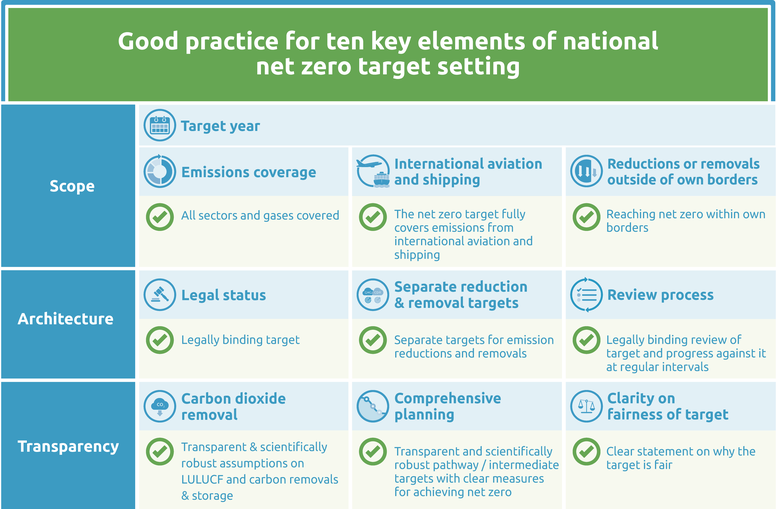Net zero targets
Summary
We evaluate the net zero target as: Poor
In its 2050 Climate Vision, The Gambia outlines its goal of achieving net zero carbon emissions by 2050, and this target is reiterated in its updated NDC (Republic of The Gambia, 2021b). The Vision is intended to underpin the country’s forthcoming Long-Term Strategy (LTS) for Low Greenhouse Gas Emissions and Climate Resilient Development.
Though The Gambia states its intention of reaching net zero by 2050 in its 2050 Climate Vision, the document does not reflect the new targets proposed in The Gambia’s updated 2021 NDC but rather the targets provided in The Gambia’s 2016 NDC (Republic of The Gambia, 2016, 2021a, 2021b). The Gambia’s net zero target does not cover all sectors, nor all GHG emissions.
CAT analysis of net zero target
Ten key elements
Scope
- Target year – The Gambia aims to reach net zero by 2050.
- Emissions coverage – The Gambia does not specify which gases are covered by its net zero target. We assume the target covers CO2 emissions only due to the reference made to “carbon" in the 2050 Climate Vision. The document covers all sectors of the economy excluding IPPU.
- International aviation and shipping – The Gambia provides no information on its intention to cover international aviation and shipping.
- Reductions or removals outside of own borders – The Gambia provides no information on its intention to use international offset credits to meet its net zero target.
Target architecture
- Legal status – The Gambia included its net zero target in its 2050 Climate Vision and referred to it in its NDC update (Republic of The Gambia, 2021b).
- Separate reduction & removal targets – The Gambia specifies separate emission reduction and removal targets. The Gambia specifies quantifiable targets for afforestation, renewable energy sources, and transportation by 2025 and 2030. However, all of these targets were listed in The Gambia’s first NDC and do not reflect the targets provided in The Gambia’s updated 2021 NDC.
- Review process – The Gambia is in the process of establishing a review cycle for its net zero target itself.
Transparency
- Carbon dioxide removal – The Gambia provides transparent assumptions only for LULUCF in 2025, 2030 and in the net zero target year.
- Comprehensive planning – The Gambia is working on a forthcoming LTS, which will detail the implementation strategy to achieve net zero carbon emissions by 2050. The net zero goal has interim targets for 2025 and 2030.
- Clarity on fairness of target – The Gambia’s 2050 Climate Vision explains that the target is fair since The Gambia’s contribution to climate change has always been marginal.
Good practice
The Climate Action Tracker has defined the following good practice for all ten key elements of net zero targets. Countries can refer to this good practice to design or enhance their net zero targets.

Further analysis
Latest publications
Stay informed
Subscribe to our newsletter






